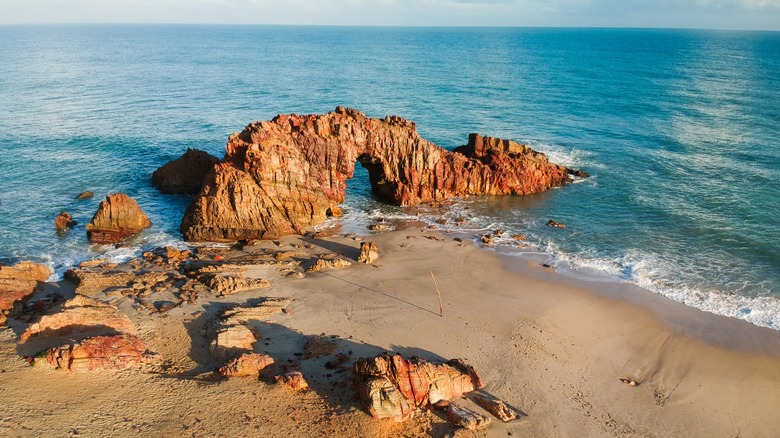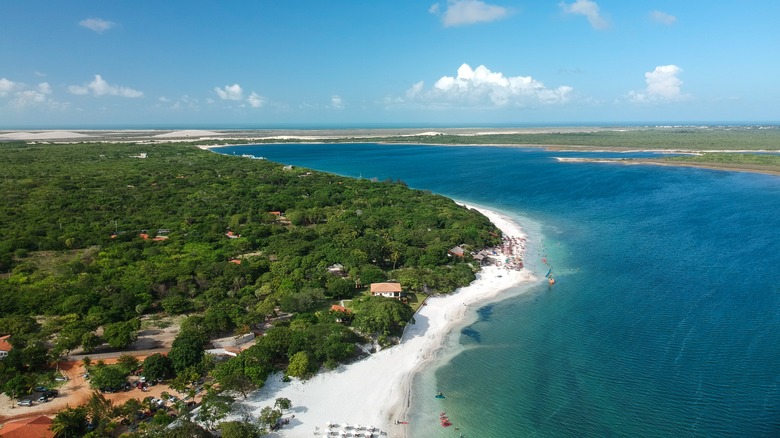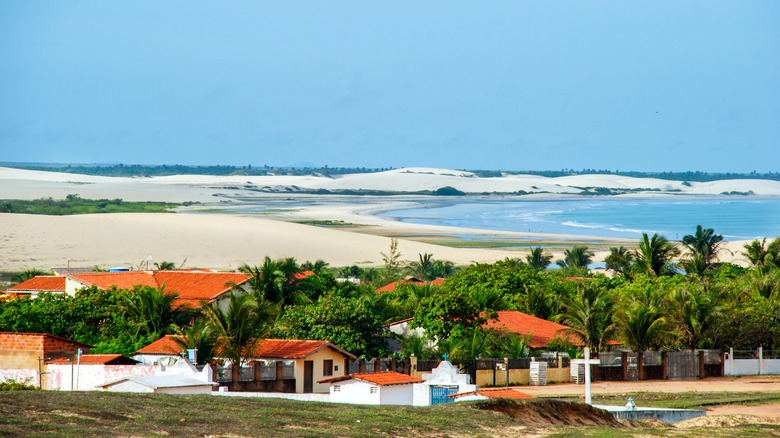This Lush National Park In South America Is Loaded With White Sand, Clear Water Beaches
When you think of visiting a national park, you might have visions of mountain climbing, tall trees, and vast stretches of hiking trails. What may not pop into your head is a national park with gorgeous beaches and sand dunes or windsurfing on emerald and blue water. However, this beautiful national park in Brazil has just that, as well as stunning rock formations and a lovely village with restaurants and shops. If you're from the United States, Canada, and Australia, keep in mind that you will need a visa to visit this stunning South American country starting April 10, 2024.
This incredible place is Jericoacoara National Park (Parque Nacional de Jericoacoara in Portuguese) in Ceará, Brazil. (Many people call it "Jeri" for short.) This area was declared an Environment Protection Area in 1984 and became a national park in 2002. It's relatively quiet, though tourists are beginning to discover it. This is one of those trip-of-a-lifetime parks, and it's got a lot that makes it unique, including streets made of sand and not asphalt. Let's take a look at Jericoacoara National Park, the village inside, and what to do while you're there.
The beaches of Jericoacoara National Park
In truth, the white sand beaches with emerald and blue waters draw people to Jeri. Check out the Blue Lagoon (Lagoa Azul) for a lovely place to windsurf. The whole park has a nice amount of warm breezes, making things like sailing, windsurfing, kitesurfing, and other similar activities a joy. If you're at the dunes at sunset, you may see people practicing Capoeira, the Brazilian martial arts style.
Another good beach for windsurfing is Preá Beach, which also has restaurants and snack areas. So does Malhada Beach, which is a bit wavy and ideal if you love to surf. It's also quieter than some of the others. Torta Lagoon (Lagoa da Torta) is a beach that can be reached by dune buggy and has kiosks for snacks and emerald water. While you're in Jericoacoara, make sure to sample the local fish dishes. (You might want to share a bite with the animals, like cats, dogs, donkeys, and cows, that wander this area freely.)
There are a few more things you should know. As of this writing, the entrance fee is around R$91.5. There are no ATMs here, and cash is a good idea. You should exchange money before you visit because the rates in the village can be high. Bring your medication with you, as the closest hospital is a three-hour ride, and there is only a small health center in the area. There are, however, cybercafés with Internet access if you need it.
What to do in Jericoacoara National Park
Since there are no paved roads here, it's not worth renting a car. In Jericoacoara village, right inside the park, numerous tours run to various attractions. One is a canoe tour through the mangrove forests on the Guriú River, where you may see seahorses. Another is a horseback riding jaunt on the beach or an option that takes you to several smaller villages around the area. Plus, there are so many beaches for your exploration.
One thing that you absolutely cannot miss is the giant rock formation in the first photo, called Pedra Furada. It's a beautiful spot to take pictures (but you aren't permitted to climb it), and you can see the sun setting through it from July 15 through August 15. It sits at the base of the Serrote, a hill around 190 feet high, giving you a view of the entire area.
The village has plenty of restaurants, as well as guest houses, hotels, inns, and camping spots. However, keep in mind that it gets incredibly dark at night — by law, there are no street lights here. The weather is pretty consistent, generally hovering from the low 80s degrees Fahrenheit through the mid-90s degrees Fahrenheit, with the water around 80 degrees Fahrenheit. The rainy season is between February and June. Don't miss the 40-minute walk to the lighthouse, built in 1933, for another fantastic view.


